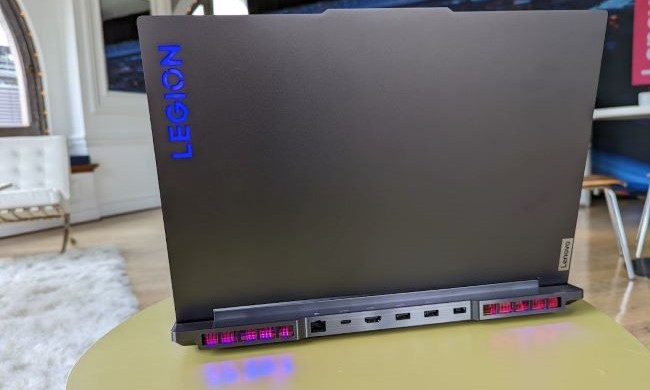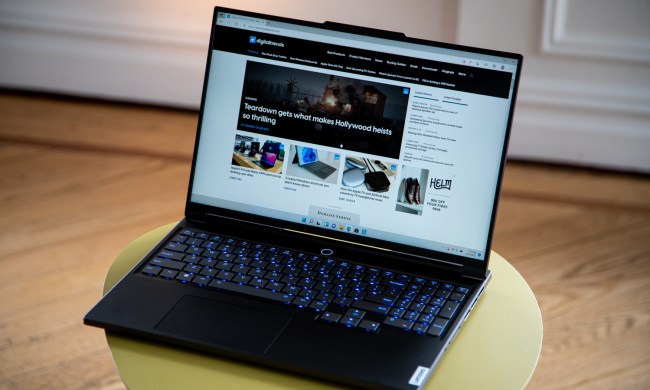- Sturdy, attractive design
- Large touchpad
- Runs cool
- Small for a 14” laptop
- Excellent overall performance
- Glossy, mediocre display
- So-so battery life
- Gaming performance could be better
In the eyes of enthusiasts, Lenovo is still known primarily for its ThinkPad line which has carried on IBM’s legacy of rugged, affordable laptops. Lenovo has not neglected its consumer division, however. Instead, the company has aggressively pursued new designs and new products, one of which is the IdeaPad U series. Case in point is the Lenovo U400 which we are reviewing.
The U series is Lenovo’s take on the trendy, high-end laptop market that is dominated by Apple’s MacBook Pro. We reviewed a couple older models in this line over a year ago and found that design and build quality was lacking. Fortunately the tech world moves rather quickly. The entire line has moved on to new models, one of which is the Lenovo U400. While high-end models are priced at well over $1000, the mid-range model we received for review currently is sold on Amazon for $899.
For that reasonable chunk of change you’ll receive a Core i5 processor, Radeon HD 6470M discrete graphics, 6GB of RAM and a 750GB hard drive. Not mind-blowing specifications, but certainly more than your average consumer laptop offers.
It’s not the hardware that will make or break the U400, however. Design and user interface is where the balance of the battle will be fought against Apple’s products as well as Windows laptops like the HP Envy line.
By the Book
The most interesting design decision made by Lenovo in recent U series models is the book-like appearance they’ve been given, which is accomplished by providing them with color-matching lids and bottoms that are rounded along the edge where the display hinge is located.
You’ll have to look at the photos to understand the effect in full, but I can say that it is impressive – though perhaps more sensible on the smaller U260 than on this larger U400 which ends up looking more like a hard-cover magazine. Still, the U400’s exterior is a portrait of elegance and nearly trumps the MacBook in exterior beauty. If only Lenovo’s logo, which is plastered on the lid, was something more interesting than the name of the company.

Opening the U400 does nothing to end comparisons to the MacBook. Most of the chassis is metallic, which is cold and uninviting at first touch but warms quickly in response to your palms. All of the vertical corners are rounded, but there are hard horizontal edges that can (literally) be a pain.
Typing on the Chiclet keyboard quickly feels natural. It’s a little stiff, but there’s plenty of space between each key, which makes touch-typing a breeze. There’s a wealth of palm rest space as well, which means a comfortable long-term typing position isn’t hard to find. My only complaint is the layout which includes some rather small function keys. The right-side Backspace button is particularly small for example.

Touchpad quality is similar – almost perfect, but with a minor issue or two. Plenty of space is available, and the glass material used to coat it is pleasing. However, the typical Windows multi-touch skittishness is present and actually a bit worse than some other recent laptops; and at default settings I found the touchpad was so sensitive that it often registered minor movements as mouse input. A little tweaking of the settings largely eliminated this issue, however.
You won’t find many ports spoiling this laptop’s waistline. USB 3.0 is included, along with two more USB 2.0 ports, HDMI and a combo headphone/microphone jack. There’s no card reader, but there is an optical drive which, like a MacBook, ejects via a keyboard function key.
Should’ve Gone Semi-Gloss
At first glance the display seems colorful and bright, two qualities that are always a boon. Though the panel is very glossy, the backlight’s brightness is usually high enough (at maximum) to prevent reflections from being a serious annoyance. Watching several HD YouTube videos left me with a good impression of color reproduction.
However, closer inspection revealed that black level performance is poor. Though gradient test images were mostly smooth, a sudden drop-off in color levels near the extreme dark end of the image reinforced this impression. In most cases this isn’t noticeable, but in dark scenes of movies and dark photos it can be an issue.

Viewing angles are limited on the vertical axis. That’s a normal characteristic of a laptop display, but it seemed more noticeable than is typical.
Audio quality, on the other hand, was solid for a laptop. There’s not much bass (of course) and this can cause distortion at high volume in tracks that use a lot of it. However, most music is at least tolerable and volume levels are high enough to fill an office or small bedroom. Long-term desktop use will be much improved by a pair of external speakers, but if you’re taking the U400 with you on a trip, its sound is adequate.
Smaller Than You Think
The U400 officially has a 14” display, and normally that’s a good indication of how large a laptop is overall. This laptop, however, has a very thin bezel – which means that the overall physical size is smaller than one might think before handling the laptop in person. In comparison to my 13” MacBook, the U400 is just a half-inch wider and virtually identical in all other dimensions.

Stuffing the U400 into a bag isn’t difficult thanks to its small chassis too. Though the 4.36 pound weight feels heavy in-hand, this laptop is actually lighter and thinner than Apple’s 13” MacBook Pro, and much lighter than the HP Envy 14” which weighs in at a scale-topping 5.69 pounds.
Battery life is an issue that can be a serious problem for any portable laptop. There’s a constant trade-off to be made. More battery life often means more weight. Lenovo in this case is using a 4-cell battery that is integrated into the chassis, but it manages a capacity of 54Wh, which is about average.

Official estimates put endurance at seven hours, but we didn’t manage that in our testing. In Battery Eater the laptop drained in one hour and eighteen minutes while the Battery Eater Reader’s Test sapped the battery in five hours and twenty minutes. Users can expect this laptop to provide about four to five hours of web browsing and document editing.
These results are probably fine for most consumers, but they’re behind some competitors like the Dell Inspiron 14z, ASUS U36 and, of course, the Apple MacBook Pro. If battery life is a high priority, you’ll need to look elsewhere.
Keeping Cool
No matter where or how you use this laptop, it stays relatively cool and quiet. Lenovo boasts that it uses a breathable keyboard design that reduces temperatures where consumers are most likely to touch their laptop (the base and the keyboard). Overall, it does seem to have an effect. While temperatures can become uncomfortable while under heavy load, using this computer in your lap is comfortable in most situations.
Software, not Bloatware
There’s plenty of pre-installed software on the U400 including Lenovo YouCam, PowerDVD, Cyberlink Power2Go, and more. Although the icons on the deskop after first boot may seem intimidating, none of the pre-installed software is annoying and most of it doesn’t start at boot, either.

Performance
Our Lenovo U400 review unit came equipped with a Core i5-2430M processor with a base clock of 2.4 GHz, 6GB of RAM and ATI’s Radeon HD 6470M graphics. This is a beefy combination, but not the most powerful offered by Lenovo, as a dual-core Core i7 processor and up to 8GBs of RAM can be optioned.
We’ve tested Core i5 mobile processors in the past, so we had a good idea of what to expect. The U400 did not disappoint. SiSoft Sandra’s processor arithmetic test reported a combined score of 38.2 GOPS, which is among the highest results we’ve received from a dual-core laptop. 7-Zip’s built-in benchmark returned a combined score of 7662, which is also an excellent result.

This success was not carried on to 3DMark 11 however, as the U400 scored only 594 while the HP Envy 14 managed a score of 954. This is due to the Radeon HD 6470M discrete GPU which, though better than Intel’s IGP 3000, is one of ATI’s most basic solutions.
Still, I was able to play Dawn of War 2: Retribution with detail settings at low, so gaming on this system isn’t hopeless. Just don’t expect to play demanding new titles without turning the detail settings and possibly the resolution way down.
Conclusion
Lenovo’s U400 is a fantastic combination of performance and design. Though the Radeon HD 6470M is a bit of a letdown, the laptop is otherwise a strong performer. There’s more than enough power here for most consumers, or even most enthusiasts.
You can buy a lot more bang for $899, however, so it’s clear that hardware value is not the goal. Instead, Lenovo is trying to win over consumers with design, and I think they might be on to something. Sturdy, elegant and functional, the Lenovo U400 is arguably more attractive than the MacBook Pro (if Lenovo removed its logo from the lid, I’d be able to remove the “arguably.”) And while there are many elements here that are reminiscent of Apple’s famous laptop line, Lenovo’s book-like design is recognizably different even from across the room.
Unfortunately, there are two flaws. One is the display, which is too glossy and offers only moderate image quality. Cheap displays are acceptable in cheap laptops, but once a company starts classing up the chassis, failing to also class up the display becomes more noticeable. Lenovo should consider offering a low-gloss or matte option, which currently is not available.
The other problem is battery endurance, which isn’t outstanding for a high-end ultraportable. Though most consumers will never need more, frequent fliers will likely prefer an Apple or ASUS product.
When the pros and cons are added, however, these issues can’t overwhelm the advantages. This is a beautiful laptop with a pleasurable user interface and excellent performance, all offered for under $1000. Though I’d personally pick the HP Envy 14 instead (because of better gaming performance) those less concerned with doing some pew-pew while on the go will prefer this laptop’s lighter, smaller, more attractive chassis.
Highs:
- Sturdy, attractive design
- Large touchpad
- Runs cool
- Small for a 14” laptop
- Excellent overall performance
Lows:
- Glossy, mediocre display
- So-so battery life
- Gaming performance could be better




